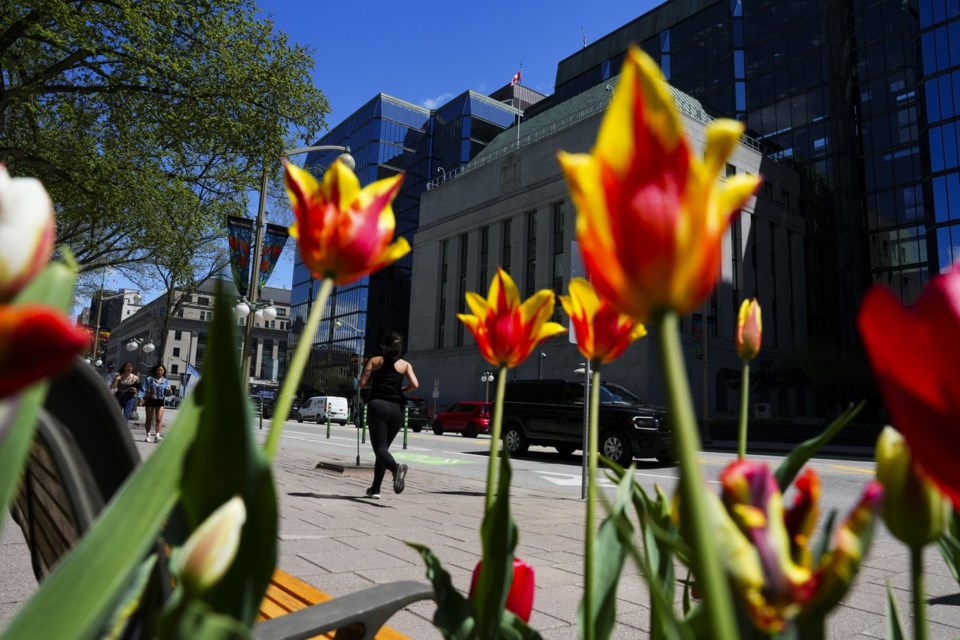OTTAWA — The annual inflation rate unexpectedly ticked higher in May, raising doubts about what the Bank of Canada will do when it makes its next interest rate decision in July in "bumpy and choppy" conditions.
Statistics Canada said Tuesday the annual rate rose to 2.9 per cent in May, compared with 2.7 per cent in April.
The move higher follows a decision by the Bank of Canada, which targets an annual inflation rate of two per cent, to cut its benchmark interest rate by a quarter of a percentage point earlier this month to 4.75 per cent.
TD Bank senior economist James Orlando called the inflation report a disappointment as both core and overall inflation rose.
"Now, one bad inflation print doesn't make a trend, and inflation remained below three per cent," Orlando wrote in a report.
"But it does speak to the unevenness of the path back to two per cent. For this reason, we think the BoC will likely pause at its July meeting, before cutting rates again in September."
The Bank of Canada's next rate decision is set for July 24 when it will also publish its latest outlook for the economy in its monetary policy report. Following the inflation report, financial markets suggested the odds that the central bank would cut rates in July were lower.
However, Olivia Cross, North America economist at Capital Economics, noted that some of the strength in inflation was due to factors that are likely to be one-offs, and given there is another inflation report before the late July meeting, she stuck with her view that the bank will cut again next month.
"While the latest release does increase the chances of the bank pausing at its July meeting, the other major data releases before then — including the June CPI release — could sway the bank’s thinking," Cross wrote.
In addition to the June inflation figures, Statistics Canada will release its gross domestic product figures for April and its labour force survey for June. The Bank of Canada will also release its own business outlook survey and Canadian survey of consumer expectations on July 15.
Dawn Desjardins, chief economist at Deloitte Canada, said the central bank will be scrutinizing the upcoming data.
"They themselves have really said it's going to be bumpy and choppy," Desjardins said of the Bank of Canada.
"But overall, is it enough to say, OK, we need to really step back completely from rate reductions — I don't think so."
A summary of the deliberations by the Bank of Canada's governing council regarding its June rate decision suggested the central bank considered waiting until July to lower interest rates but ultimately decided to cut earlier.
"While they recognized the risk that progress could stall — as it had in the United States — there was consensus that with four consecutive months of easing in core inflation and indicators suggesting continued downward momentum, there had been sufficient progress to warrant a first cut in the policy rate," the summary said.
Statistics Canada said Tuesday the overall inflation increase for May came as prices for services rose 4.6 per cent from a year ago, up from a 4.2 per cent increase in April. Prices for goods grew at the same rate as April at one per cent.
Mortgage interest costs were up 23.3 per cent compared with a year ago, while rent prices were up 8.9 per cent.
Prices in May for travel tours rose 6.9 per cent compared with a year ago while air transportation prices increased 4.5 per cent.
Gasoline prices were up 5.6 per cent compared with a year ago.
Grocery prices rose 1.5 per cent year-over-year in May, a tick higher compared with April, when they rose 1.4 per cent. It's the first acceleration in grocery prices since June last year, however Statistics Canada said consumers are paying 22.5 per cent more for groceries compared with May 2020.
This report by The Canadian Press was first published June 25, 2024.
Craig Wong, The Canadian Press

